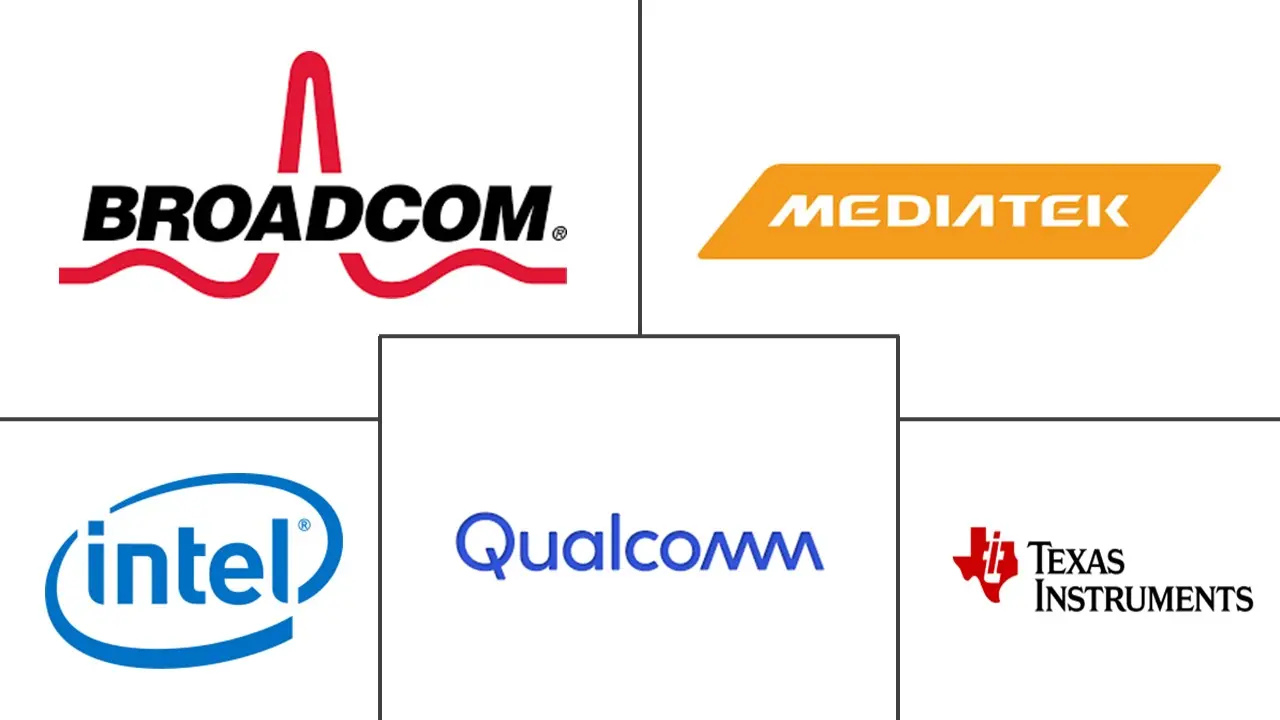Wi-Fi Chipset Market Size and Share
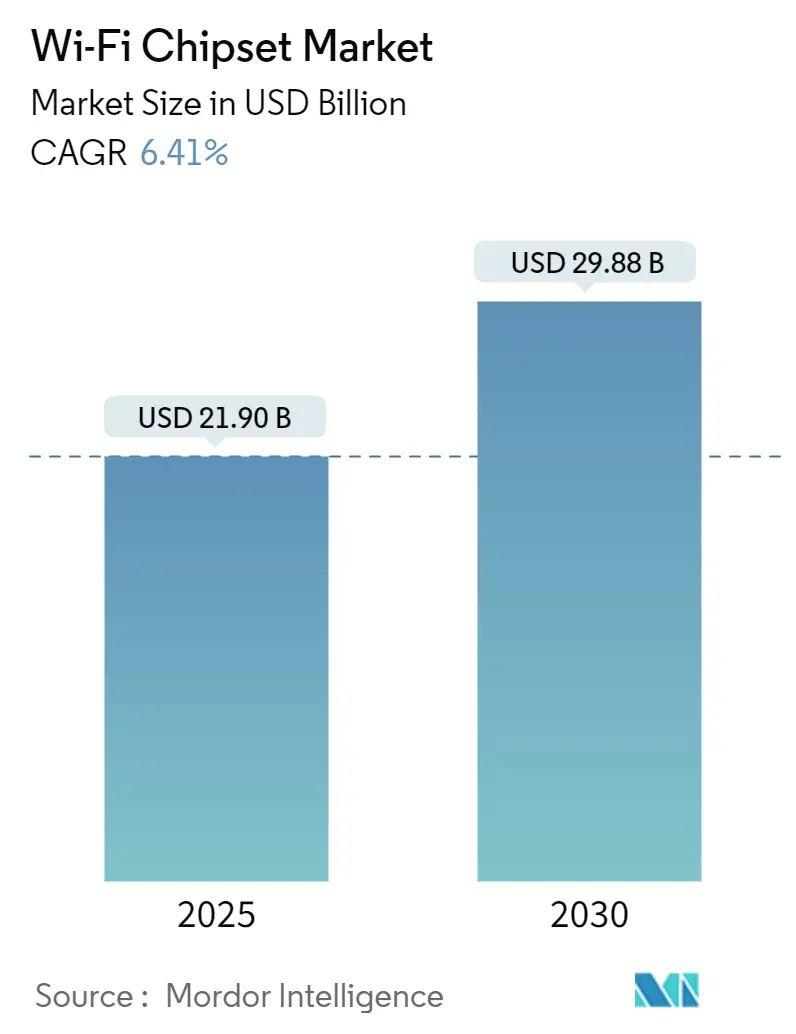
Wi-Fi Chipset Market Analysis by Mordor Intelligence
The Wi-Fi chipset market size is valued at USD 21.90 billion in 2025 and is projected to reach USD 29.88 billion by 2030, advancing at a 6.41% CAGR. Expansion aligns with the shift from legacy standards toward Wi-Fi 6, Wi-Fi 6E, and Wi-Fi 7, fueled by enterprise digital-first strategies, high-bandwidth consumer electronics, and the need for dense, low-latency connectivity in public venues.[1]Source: Wi-Fi Alliance, “Wi-Fi 6 and Wi-Fi 6E Drive Global Market Opportunities,” wi-fi.orgSemiconductor vendors with access to advanced process nodes secure early wins as Wi-Fi 7 design activity accelerates, while demand for power-efficient chipsets in smart-home and industrial IoT devices deepens supplier pipelines. The Asia-Pacific production ecosystem keeps bill-of-materials costs low and shortens lead times, allowing regional OEMs to launch mesh gateways and multi-user MIMO routers at price points that drive mass adoption. Automotive infotainment projects and V2X pilots are converting backlogs into volume orders, giving the Wi-Fi chipset market an additional growth lever across the latter half of the forecast period. Vendor competition centers on integrating Wi-Fi, Bluetooth, Thread, and Ultra-Wideband into single packages that simplify board layouts for device makers.
Key Report Takeaways
- By standard, Wi-Fi 6/6E led with a 40.9% revenue share in 2024; the “Others” category, anchored by Wi-Fi 7, is forecast to expand at a 7.0% CAGR to 2030.
- By MIMO configuration, MU-MIMO captured 61.2% of the Wi-Fi chipset market share in 2024 and also registers the highest projected 6.9% CAGR through 2030.
- By device application, smartphones accounted for 39.8% of the Wi-Fi chipset market size in 2024, while the router and broadband gateway segment records the fastest 8.1% CAGR over 2025-2030.
- By end-user, residential consumer electronics held a 61.4% share in 2024; automotive is poised for an 8.3% CAGR, the steepest among all categories.
- By geography, Asia-Pacific commanded 43.2% of 2024 shipments and continues to be the fastest-growing region at a 7.8% CAGR through 2030.
Global Wi-Fi Chipset Market Trends and Insights
Driver Imapct Analysis
| DRIVER | (~) % IMPACT ON CAGR FORECAST | GEOGRAPHIC RELEVANCE | IMPACT TIMELINE |
|---|---|---|---|
| Proliferation of public Wi-Fi hotspots and IoT connections | +1.2% | Global, Asia-Pacific and North America lead | Medium term (2-4 years) |
| Rising internet penetration and demand for high-speed connectivity | +1.0% | Global, strongest in emerging markets | Long term (≥ 4 years) |
| Rapid adoption of Wi-Fi 6/6E in enterprise networks | +1.5% | North America and Europe lead, Asia-Pacific follows | Short term (≤ 2 years) |
| Growth in smart-home devices and residential mesh networking | +0.9% | North America, Europe, urban Asia-Pacific | Medium term (2-4 years) |
| Integration of Wi-Fi HaLow for low-power industrial IoT | +0.6% | Industrial hubs in North America, Europe, East Asia | Long term (≥ 4 years) |
| Regulatory opening of 6-7 GHz spectrum accelerating Wi-Fi 7 | +1.1% | North America, Europe, select Asia-Pacific | Short term (≤ 2 years) |
| Source: Mordor Intelligence | |||
Rapid Adoption of Wi-Fi 6/6E in Enterprise Networks
Corporate campus upgrades began moving from pilot to full-scale rollouts in 2024, pushed by the 1,200 MHz of 6 GHz spectrum released by the FCC. Added channels permit larger 320 MHz widths that quintuple throughput versus Wi-Fi 5, giving IT teams capacity headroom for 8K media streams and latency-sensitive collaboration tools. More than 400 Wi-Fi 6E-certified devices had reached commercial availability by 2024, and enterprise-class access points formed the fastest-growing certification subcategory. Facilities teams report lower troubleshooting tickets as clean 6 GHz channels avoid interference created by legacy devices operating at 2.4 GHz and 5 GHz. Vendors position Wi-Fi 6E hardware as future-proof investments that accept software upgrades to Wi-Fi 7 when spectrum becomes available. Procurement cycles are shortened to under 15 months in verticals such as healthcare and finance, where always-on wireless is now an operational prerequisite.
Growth in Smart-Home Devices and Residential Mesh Networking
Household device density surpassed 30 connected endpoints in many urban dwellings during 2024, and forecasts suggest averages above 50 by 2028. That surge forces service providers to redesign gateways around tri-radio chipsets capable of dedicating 6 GHz backhaul links between mesh nodes. Wi-Fi 6E gateways thus prevent 4K streaming boxes from crowding thermostats and security cameras that still operate on 2.4 GHz. Beamforming and seamless handoff software within new chipsets sustain consistent throughput as occupants roam from room to room, addressing a top driver of support calls. Mature power-save modes extend battery life for low-duty-cycle sensors, trimming truck-roll costs for internet service providers. Broadcom quantified a double-digit drop in field-support incidents after deploying 6 GHz-enabled gateways across select North American fiber footprints.[2]Source: Broadcom, “Unprecedented Success of Opening 6 GHz Band to Wi-Fi,” broadcom.com
Integration of Wi-Fi HaLow for Low-Power Industrial IoT
Wi-Fi HaLow (802.11ah) uses sub-1 GHz frequencies to push signals more than 1 km, ten times farther than traditional Wi-Fi links while consuming under one-tenth the power. Support for up to 8,191 devices per access point scales battery-operated sensors across factories and warehouses. Penetration through concrete and metal lowers infrastructure costs because fewer access points are needed. Certifications begin in late 2024, giving industrial solution providers a standards-based alternative to proprietary LPWAN schemes. Predictive maintenance, asset tracking, and environmental monitoring are near-term beneficiaries, especially where replacement batteries are costly to access. Early evaluations show multi-year battery life for vibration sensors mounted on remote rotating equipment.
Regulatory Opening of 6-7 GHz Spectrum Accelerating Wi-Fi 7
Sixty-plus countries have assigned at least part of the 6 GHz band for license-exempt Wi-Fi use, creating a path toward global Wi-Fi 7 interoperability. Europe’s CEPT plans to authorize the 6.425–7.125 GHz range by 2027, potentially doubling continental spectrum. Japan finalized rules in 2024 that mirror U.S. allocations, unlocking local demand for tri-radio gateways. Wi-Fi 7 introduces Multi-Link Operation that bonds 2.4 GHz, 5 GHz, and 6 GHz channels, yielding headline throughput above 40 Gbps and sub-2 ms latency. Device forecasts point to 2.1 billion Wi-Fi 7 chipsets in active use by 2028, with television makers and broadband operators at the front of the adoption wave. Competitive differentiation now hinges on delivering working MLO firmware before rivals.
Restraints Impact Analysis
| RESTRAINTS | (~) % IMPACT ON CAGR FORECAST | GEOGRAPHIC RELEVANCE | IMPACT TIMELINE |
|---|---|---|---|
| Network security threats and complex management | -0.8% | Global, enterprise most affected | Short term (≤ 2 years) |
| Competition from cellular 5G/LPWAN alternatives in IoT | -0.6% | Global, industrial IoT focus | Medium term (2-4 years) |
| Semiconductor fabrication capacity constraints (< 6 nm) | -0.7% | Global supply chain | Short term (≤ 2 years) |
| Fragmented regional spectrum regulations for Wi-Fi 7 | -0.5% | Mainly Asia-Pacific and emerging markets | Medium term (2-4 years) |
| Source: Mordor Intelligence | |||
Network Security Threats and Complex Management
Transitioning to WPA3 hardens Wi-Fi networks, yet mixed-generation device fleets create compatibility gaps that slow enterprise upgrades. Multi-Link Operation in Wi-Fi 7 multiplies policy sets because each frequency link demands synchronized encryption credentials. IT administrators, therefore, invest in automated policy engines that escalate costs and lengthen deployment timetables. The influx of unmanaged IoT devices widens attack surfaces, prompting stricter network segmentation and zero-trust architectures that strain limited staff resources. Automated Frequency Coordination databases required for outdoor 6 GHz channels further complicate change-management workflows, pushing some organizations to slow rollouts until vendor tooling matures.
Semiconductor Fabrication Capacity Constraints (< 6 nm)
Sub-6 nm processes are mandatory for full-featured Wi-Fi 7 SoCs that integrate advanced MAC engines and AI-assisted network optimization blocks. Foundry output remains heavily booked by high-performance computing customers, limiting wafer availability for connectivity silicon. Lead-times beyond 40 weeks force smaller chipset suppliers to prioritize top-line components, delaying volume shipments to low-margin device categories. Cost pressures surface when capacity premiums flow downstream, raising average selling prices for consumer gateways. Suppliers with multi-year wafer agreements or in-house front-end module lines enjoy a buffer, while new entrants face steep barriers to scale.
Segment Analysis
By Standard: Wi-Fi 7 Emergence Reshaping Technology Landscape
Wi-Fi 6 and Wi-Fi 6E together commanded 40.9% revenue share in 2024 as the preferred upgrade path for enterprise campus refresh projects. The segment benefits from backward compatibility and certified client ecosystems, anchoring the Wi-Fi chipset market through the mid-term horizon. The Others category, dominated by Wi-Fi 7 designs, is set to record the fastest 7.0% CAGR as chipmakers finalize 320 MHz channel architectures that multiply spectral efficiency. Apple’s flagship smartphones and laptop platforms are scheduled to integrate tri-band Wi-Fi 7 radios in 2025, which typically triggers accelerated LAN infrastructure investment by corporations aligning device and access-point capabilities. Filogic-based Wi-Fi 7 gateways demonstrated 4× higher uplink throughput in operator lab tests, underscoring differentiation over Wi-Fi 6E predecessors.
Growing demand for virtual reality, cloud gaming, and ultra-high-definition streaming elevates throughput expectations beyond the ceiling of Wi-Fi 6E. Early adopters place strategic orders for access points that feature Automatic Frequency Coordination clients to satisfy 6 GHz incumbent protections in outdoor venues. Market education campaigns from chipset vendors emphasize latency reduction in the single-millisecond range, critical for bidirectional XR use cases. As the Wi-Fi chipset market transitions, component suppliers that offer modular reference designs accelerate customer time-to-market and lock in design wins across CPE, PC, and smartphone verticals.
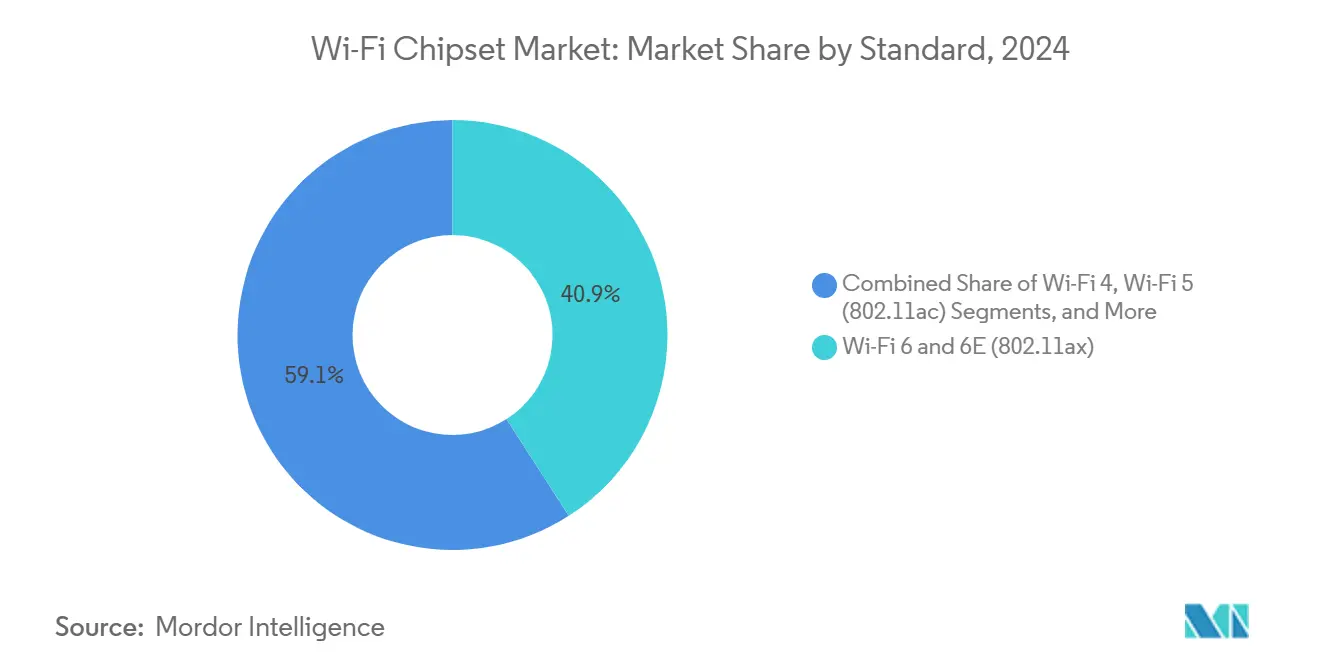
Note: Segment shares of all individual segments available upon report purchase
By MIMO Configuration: MU-MIMO Dominance Driven by Density Requirements
MU-MIMO solutions generated 61.2% of 2024 sales and registered a 6.9% CAGR through 2030. Eight-stream access points push simultaneous downlink and uplink data to dozens of devices, a capability vital for lecture halls and transportation hubs that often peak above 500 concurrent users. Advances in beamforming algorithms embedded inside Wi-Fi 6E and Wi-Fi 7 PHY layers sustain signal integrity even in reflective indoor environments. The Wi-Fi chipset market size attached to MU-MIMO implementations benefits from premium ASPs for high-end enterprise gear.
SU-MIMO chipsets remain in entry-level gateways and price-sensitive IoT nodes where single-threaded communication remains sufficient. Yet as IoT density rises, even consumer access points are migrating to four-stream MU-MIMO designs to minimize airtime contention. Component vendors embed AI acceleration blocks that analyze client telemetry and dynamically allocate spatial streams, assuring predictable application performance for videoconferencing apps that dominate residential upstream traffic.
By Device Application: Routers and Gateways Lead Growth Transformation
Smartphones produced 39.8% of Wi-Fi chipset market revenue in 2024, driven by cyclical refresh cycles and 5G coexistence requirements. However, router and broadband gateway designs forecast an 8.1% CAGR through 2030 as fiber-to-the-home rollouts demand tri-band gateways capable of gigabit-class throughout. Operators calibrate hardware configurations around rising numbers of 4K set-top boxes and smart appliances per household, installing two or more satellite nodes to blanket multi-story homes.
Tablets, laptops, and desktops retain a steady share but adopt Wi-Fi 7 to support higher Wi-Fi-only productivity expectations among hybrid workers. Automotive infotainment systems represent a nascent but high-growth subsegment, boosted by over-the-air firmware updates and passenger experience requirements. NXP’s AEC-Q100-qualified dual-band Wi-Fi 6 solutions set the reference standard for gigabit connectivity in connected cars, and future Wi-Fi 7 automotive platforms plan to deliver redundant links for V2X back-haul streams.[3]Source: NXP, “88Q9098 Dual-Band 2×2 Wi-Fi 6 Automotive Solution,” nxp.com
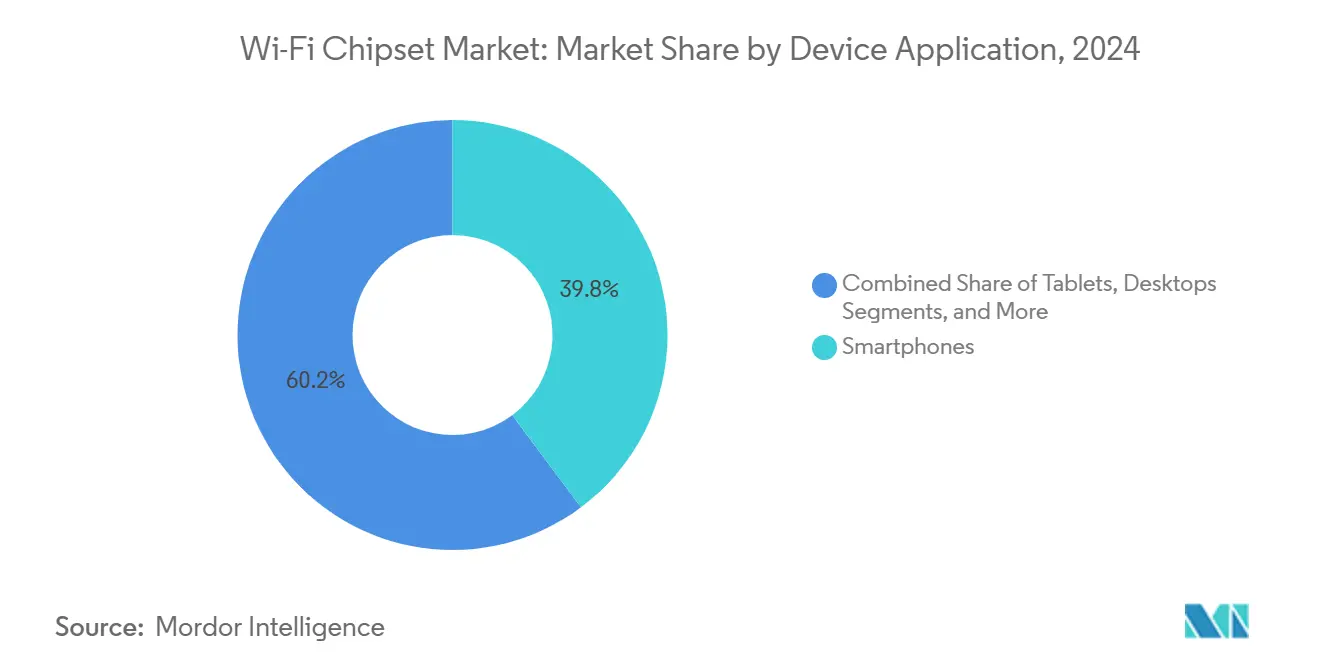
By End-User: Automotive Segment Accelerates Connected Vehicle Adoption
Residential consumer electronics captured 61.4% of 2024 shipments as mesh networking and smart-home ecosystems expanded. The Wi-Fi chipset market now prioritizes low-power operation to cater to battery-operated sensors that proliferate within homes. Enterprise demand follows digital workplace transformations that require dense access-point grids for collaboration rooms and hot-desking zones.
The automotive category is projected to post the fastest 8.3% CAGR, reflecting automakers’ push to embed Wi-Fi 6 and Wi-Fi 7 alongside 5G modems to handle high-throughput cabin entertainment and secure vehicle diagnostics. Wi-Fi Alliance projects that 95% of vehicles will ship with Wi-Fi connectivity by 2030, creating a multiyear pipeline for captive module suppliers.[4]Source: Wi-Fi Alliance, “Automotive,” wi-fi.org Industrial IoT adopters begin evaluating Wi-Fi HaLow for remote asset monitoring, while public sector deployments turn to Wi-Fi 6E for smart city video surveillance and broadband-quality public hotspots.
Geography Analysis
Asia-Pacific generated 43.2% of Wi-Fi chipset market shipments in 2024, with China, Japan, and South Korea anchoring both manufacturing and consumption. Government fiber investments across Tier-2 and Tier-3 Chinese cities stimulate demand for tri-radio gateways, although current limitations on indoor 6 GHz operation delay full-scale Wi-Fi 6E adoption. Japan’s regulatory green light for 6 GHz WLAN in 2024 sparked local OEM activity around Wi-Fi 7 routers that support 320 MHz channels, while Korean operators deploy carrier-grade Wi-Fi 6E access points inside 5G-enabled smart-city corridors. India’s surge in internet subscribers and the establishment of a Wi-Fi design center in Chennai illustrate the region’s evolving role as both an engineering hub and a high-volume consumer.
North America maintains a leadership role in enterprise deployments, leveraging the FCC’s early opening of the entire 6 GHz band. Hybrid work patterns keep demand strong for access points with dynamic channel allocation features. Service providers bundle managed Wi-Fi 7 gateways into gigabit fiber packages to reduce customer churn and differentiate beyond speed tiers. The Wi-Fi chipset market benefits from robust private-sector funding that underwrites rapid generation transitions when total cost-of-ownership models justify productivity gains.
Europe experiences accelerated Wi-Fi 7 adoption among broadband operators preparing for 8 Gbps multi-gig services. CEPT’s efforts to authorize the upper 6 GHz band would double available channels and foster symmetrical gigabit performance across densely populated metro areas. Meanwhile, South America and the Middle East, and Africa deliver emerging-market growth as cost-reduced Wi-Fi 6 chipsets migrate into mass-market smartphones and fixed-wireless gateways that bridge rural connectivity gaps. Spectrum allocation diversity across these regions complicates global SKU alignment, but standards-based certifications minimize interoperability risk for multinational OEMs.
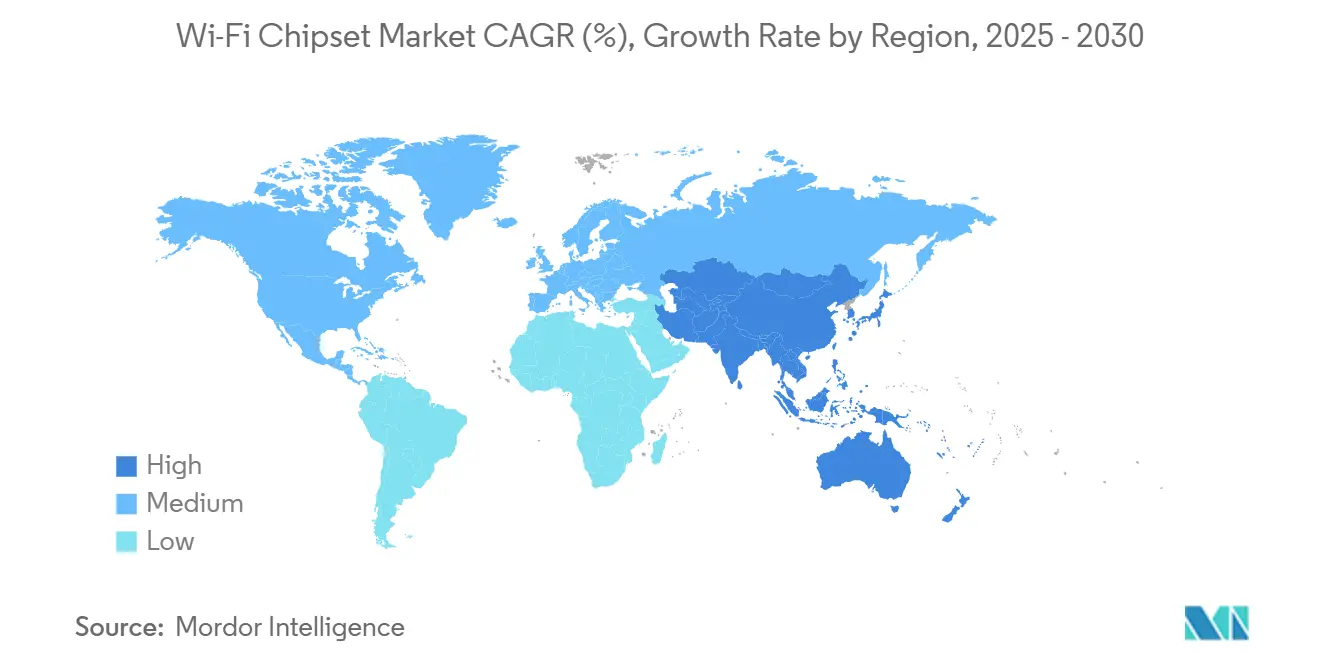
Competitive Landscape
The Wi-Fi chipset market shows moderate concentration. Qualcomm, Broadcom, and MediaTek dominate by virtue of end-to-end portfolios that span smartphones, PCs, CPE, and IoT modules. Access to sub-6 nm foundry capacity allows these firms to introduce Wi-Fi 7 silicon with integrated network-on-chip engines that offload Quality-of-Service tasks. Qualcomm partnered with STMicroelectronics to blend Wi-Fi, Bluetooth, and Thread into STM32 microcontrollers, targeting an installed base of more than 80 billion IoT devices by 2028.[5]Source: Qualcomm, “Qualcomm and STMicroelectronics Enter Strategic Collaboration in Wireless IoT,” qualcomm.com Intel integrates Wi-Fi 7 into vPro platforms, positioning desktops and laptops for 5× uplink improvements over Wi-Fi 6E.
NXP pursues vertical specialization in automotive, emphasizing AEC-Q100 qualification and UWB-assisted battery-management systems to secure design wins in connected vehicles. Vendors such as CEVA license Wi-Fi 6 IP blocks to regional fabless startups, lowering barriers for Chinese handset OEMs that seek in-house connectivity roadmaps. Component suppliers with captive front-end module lines gain margin advantages because FEM costs rise in tandem with 6 GHz coexistence filters.
Competitive intensity rises in low-power industrial IoT, where Wi-Fi HaLow creates white-space opportunities. Startups introduce sub-GHz SoCs integrating sensor controllers and power amplifiers on a single die to shrink bill-of-materials. Still, high-volume contracts go to incumbents with robust supply-chain compliance programs demanded by global industrial OEMs. Patent portfolios covering beamforming and MLO scheduling remain key bargaining chips in cross-licensing negotiations, influencing royalty structures across the ecosystem.
Wi-Fi Chipset Industry Leaders
-
Qualcomm Technologies Inc.
-
Broadcom Inc.
-
MediaTek Inc.
-
Intel Corporation
-
Texas Instruments Incorporated
- *Disclaimer: Major Players sorted in no particular order
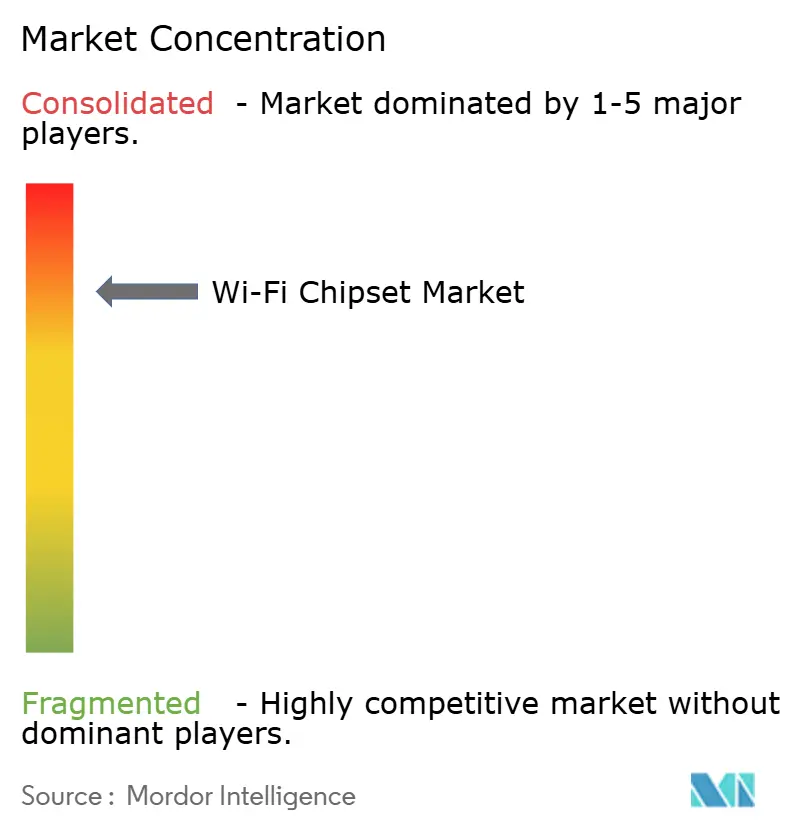


Recent Industry Developments
- March 2025: Intel unveiled its Xeon 6 system-on-chip at MWC 2025, featuring 2.4× higher RAN capacity and eight integrated Ethernet ports that deliver up to 200 Gbps aggregate throughput for virtual RAN workloads.
- February 2025: CEVA licensed its Ceva-Waves Wi-Fi 6 high-performance IP to WUQI Microelectronics for the WQ9201 combo chip targeting smartphones, tablets, and TVs.
- January 2025: onsemi completed its USD 115 million acquisition of Qorvo’s silicon-carbide JFET portfolio, expanding power semiconductor offerings for data centers, EVs, and industrial drives.
- January 2025: Honeywell and NXP expanded their collaboration to co-develop AI-enhanced avionics featuring NXP i.MX 8 processors for next-generation cockpit displays.
Global Wi-Fi Chipset Market Report Scope
A Wi-Fi chipset is a collection of integrated circuits designed to enable wireless communication in devices such as laptops, smartphones, tablets, and other electronic equipment. These chipsets are essential for facilitating the connection to Wi-Fi networks, allowing devices to access the internet without physical cables. The market is defined by the revenue generated through sales of Wi-Fi chipsets offered by various market players.
The Wi-Fi Chipset is segmented by standard (Wi-Fi 4, Wi-Fi 5 (802.11ac), Wi-Fi 6 and Wi-Fi 6E (802.11ax), Wi-Fi 7 (802.11be), others (Wi-Fi 8, and other older standards such as 802.11g, 802.11a, etc.)), by (MIMO configuration, MU-MIMO, SU-MIMO), by device application (smartphone, tablets, desktops, laptops, Wi-Fi router & broadband gateway, TV, IoTs, infotainment systems (automotive), others (drones, gaming devices, etc.)), by end-user (residential (includes consumer electronics), enterprise (includes networking), industrial, automotive, government and public, medical, others (education, commercial places, etc.), by geography (North America, Europe, Asia Pacific, rest of the World). The report offers market forecasts and size in value (USD) and volume in (units) for all the above segments.
| Wi-Fi 4 |
| Wi-Fi 5 (802.11ac) |
| Wi-Fi 6 and 6E (802.11ax) |
| Wi-Fi 7 (802.11be) |
| Other Standards (Wi-Fi 8, Older) |
| MU-MIMO |
| SU-MIMO |
| Smartphones |
| Tablets |
| Desktops |
| Laptops |
| Wi-Fi Router and Broadband Gateway |
| TV |
| IoTs |
| Infotainment Systems (Automotive) |
| Other Device Applications (Drones, Gaming Devices) |
| Residential (Consumer Electronics) |
| Enterprise (Networking) |
| Industrial |
| Automotive |
| Government and Public |
| Medical |
| Other End-Users (Education, Commercial) |
| North America | United States | |
| Canada | ||
| Mexico | ||
| South America | Brazil | |
| Argentina | ||
| Rest of South America | ||
| Europe | Germany | |
| United Kingdom | ||
| France | ||
| Russia | ||
| Rest of Europe | ||
| Asia-Pacific | China | |
| Japan | ||
| India | ||
| South Korea | ||
| South-East Asia | ||
| Rest of Asia-Pacific | ||
| Middle East and Africa | Middle East | Saudi Arabia |
| United Arab Emirates | ||
| Rest of Middle East | ||
| Africa | South Africa | |
| Egypt | ||
| Rest of Africa | ||
| By Standard | Wi-Fi 4 | ||
| Wi-Fi 5 (802.11ac) | |||
| Wi-Fi 6 and 6E (802.11ax) | |||
| Wi-Fi 7 (802.11be) | |||
| Other Standards (Wi-Fi 8, Older) | |||
| By MIMO Configuration | MU-MIMO | ||
| SU-MIMO | |||
| By Device Application | Smartphones | ||
| Tablets | |||
| Desktops | |||
| Laptops | |||
| Wi-Fi Router and Broadband Gateway | |||
| TV | |||
| IoTs | |||
| Infotainment Systems (Automotive) | |||
| Other Device Applications (Drones, Gaming Devices) | |||
| By End-User | Residential (Consumer Electronics) | ||
| Enterprise (Networking) | |||
| Industrial | |||
| Automotive | |||
| Government and Public | |||
| Medical | |||
| Other End-Users (Education, Commercial) | |||
| By Geography | North America | United States | |
| Canada | |||
| Mexico | |||
| South America | Brazil | ||
| Argentina | |||
| Rest of South America | |||
| Europe | Germany | ||
| United Kingdom | |||
| France | |||
| Russia | |||
| Rest of Europe | |||
| Asia-Pacific | China | ||
| Japan | |||
| India | |||
| South Korea | |||
| South-East Asia | |||
| Rest of Asia-Pacific | |||
| Middle East and Africa | Middle East | Saudi Arabia | |
| United Arab Emirates | |||
| Rest of Middle East | |||
| Africa | South Africa | ||
| Egypt | |||
| Rest of Africa | |||


Key Questions Answered in the Report
What CAGR is projected for global Wi-Fi chipset sales through 2030?
The Wi-Fi chipset market is forecast to expand at a 6.41% CAGR from 2025 to 2030.
Which region currently leads demand for Wi-Fi chipsets?
Asia-Pacific held 43.2% of 2024 shipments and is also the fastest-growing region through 2030.
How will Wi-Fi 7 affect enterprise network upgrades?
Wi-Fi 7 triples available channel width and introduces Multi-Link Operation, driving enterprises to refresh access-point fleets for higher throughput and lower latency.
Why are routers and gateways the fastest-growing device segment?
Fiber-to-the-home rollouts and mesh networking spur operator demand for tri-radio gateways, resulting in an 8.1% CAGR for this category.
Page last updated on:
